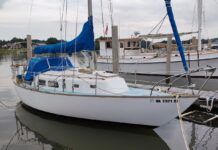Hunter 27 Used Boat Review
The Hunter 27 is the smallest boat in the Hunter line, which runs up to 43' in length. The Hunter 27 is a popular boat with first-time sailboat buyers, and with small-boat sailors purchasing their first auxiliary cruising boat. Since the boat was introduced in 1975, thousands have been built. Judging from the response of Hunter owners we've talked to, all Hunters, including the 27, are purchased for one reason: price. The Hunter 27 is just about the cheapest diesel-powered 27' cruising boat money can buy.
PY26 Used Boat Review
This C. Raymond Hunt design from the 1970’s has standing room and ample beam, making her a roomy family coastal cruiser. Our criticisms are few, the most serious of which is the iron keel.
Catalina 25 Used Boat Review
The Catalina 25 is not exceptionally fast, stylish, or spacious compared to newer widebody models, and while the construction and workmanship are adequate, they too are not exceptional. But because of the builder's strict adherence to a philosophy of offering a relatively spacious design, relatively well made, at a reasonable price, and backing up the product with generally good customer service, the Catalina 25 has turned out to be one of the most successful small cruising sailboats ever built, with 5,332 boats sold between 1976 and 1990, when the company ceased producing the model as demand tailed off.
O’Day 30 Used Boat Review
Over 350 O'Day 30s were built between 1977 and 1984. During 1984, the 30 was modified by changing the keel and rudder, and the stern was lengthened to accommodate a European-style boarding platform. This "new boat" was called the O'Day 31, and it stayed in production until 1986.
Nonsuch 30 Used Boat Review
The Nonsuch 30 is an oddity. She is a fin keeled, spade ruddered boat with an unstayed wishbone cat rig. Weird. She is the concept of retired ocean racer Gordon Fisher, the design of Mark Ellis, and the created child of Hinterhoeller, who is one of the few production boatbuilders with the legitimate title Master Boatbuilder, earned the hard way through apprenticeship in Europe.
Hunter 30 Used Boat Review
Hunter Marine began building auxiliary sailboats in 1974, largely as the result of the first oil embargo and the new energy consciousness that followed. Founded by Warren Luhrs, Hunter began as a division of the powerboat-maker Silverton Yachts, which was interested in expanding its offerings and taking advantage of the new interest in saving fuel.
Catalina 22 Used Boat Review
In its 10th anniversary issue in 1980, Sail magazine named the Catalina 22 the boat that had represented the "breakthrough" in "trailer/cruisers" in those 10 years. We might quibble with its selection over more out-and-out trailerable boats such as the Ventures, but there is no denying the popularity of the Catalina: more than 10,000 have been built and sales continue to be strong.For many buyers the Catalina 22 is their first "big" boat and an introduction to the Catalina line. Many remain with Catalina and buy up within that line.
Cape Dory 30 Used Boat Review
No one buys a Cape Dory looking for a flashy speedster. The original ketch rig has a lot of windage, and relatively small, inefficient sails. The rig does, however, give the boat a distinctly "shippy" traditional appearance.
Islander Bahama 30 Used Boat Review
More than a few years ago my wife Carey and I were looking to move up from our O’Day 25 to something a little...
MacGregor 26M Used Boat Review
MacGregor 26 has been a staple in the trailerable sailboat market for decades, and company literature claimed more than 7,000 of the original model...


















































